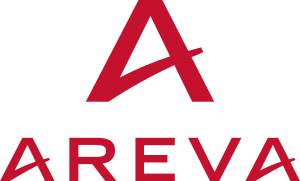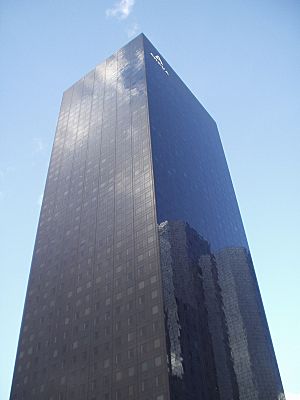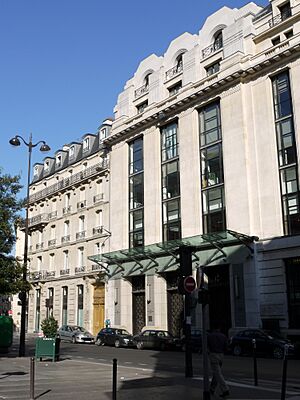Areva facts for kids
 |
|

Headquarters in Courbevoie, France
|
|
| State-owned enterprise | |
| Industry | Nuclear industry |
| Predecessors | Framatome Cogema TechnicAtome |
| Successors | Framatome Orano TechnicAtome |
| Founded | 2001 |
| Defunct | 2018 |
| Headquarters |
Courbevoie, Paris
,
France
|
|
Area served
|
Worldwide |
|
Key people
|
Philippe Braidy (chairman and chief executive officer) |
| Products | Nuclear reactors Nuclear fuel Uranium Electric power |
| Services | Nuclear enrichment Nuclear material transport Nuclear reprocessing |
| Owner | Government of France |
|
Number of employees
|
45,340 (2013) |
| Subsidiaries |
|
Areva S.A. was a big French company that worked with nuclear power. It operated from 2001 to 2018. Its main office was in Courbevoie, France. Most of Areva was owned by the French government. Other owners included the Kuwait Investment Authority.
Areva went through a big change because of financial problems. It sold or stopped its renewable energy businesses. It also sold its reactor part, Areva NP, which went back to its old name, Framatome. The part that worked on nuclear engines and research reactors, Areva TA, was sold to a French government agency. Its nuclear fuel business became a new company called New Areva, which is now Orano. A new company, Areva S.A., was created to handle ongoing projects and sales.
By 2018, the sales of Areva TA and Areva NP were finished. New Areva became Orano. These changes marked the end of the original Areva group.
Contents
History of Areva
How Areva Started
Areva was formed on April 3, 2001. It was created by combining three companies: Framatome, Cogema, and Technicatome. These companies later became parts of Areva. Anne Lauvergeon was the first CEO of the new company.
In 2003, Areva won a contract to build a new nuclear power plant in Olkiluoto, Finland. This plant would use a modern reactor design. Construction began in 2005.
Areva also bought other businesses over the years. In 2004, it bought parts of Alstom that dealt with electricity. These parts were later sold back to Alstom and Schneider Electric in 2010. Areva also started a joint company with Constellation Energy in the United States to sell nuclear reactors.
In 2006, Areva started a new group for renewable energy. This included projects like wind turbines. They bought a company called Multibrid, which made offshore wind turbines. Areva also bought a company called UraMin in 2007, which mined uranium.
Areva began building another reactor in France in 2007. They also made a big deal with China to supply two more reactors. Areva and Mitsubishi Heavy Industries also created a joint company to develop a new type of reactor.
In 2011, Areva became a publicly traded company on the Euronext stock exchange in Paris.
Challenges After Fukushima
After the Fukushima nuclear accident in 2011, Areva faced difficulties. In December 2011, the company stopped building work at several sites. This included plants in France, Africa, and the United States. They also had to write off a lot of money from their purchase of the uranium mining company Uramin. This was because the uranium deposits were not as valuable as first thought.
Areva's financial situation worsened. In 2015, a credit rating agency lowered Areva's rating. This meant the company was seen as a higher risk for investors.
Despite these challenges, Areva continued some projects. In 2012, it bought a company that developed hydrogen technology. They also worked on a system to store solar energy using hydrogen. In 2014, Areva partnered with a Spanish company to create a joint venture for wind turbines. However, Areva left the solar energy business in 2014.
In 2013, Areva won a large contract to supply reactors for the Hinkley Point C nuclear power station in England. They also agreed to work with a Chinese company on renewable energy projects.
In 2015, problems were found with steel parts made by one of Areva's factories, Le Creusot Forge. These parts had issues that could weaken the steel. This led to checks on many nuclear reactors and caused some power plants to shut down temporarily. Inspectors later found problems with records from the factory.
Areva's Restructuring
In June 2016, Areva announced its plans to reorganize. This included selling most of its reactor business to EDF. The Olkiluoto 3 EPR project in Finland remained with Areva SA. Areva also created a new company for its fuel cycle business, which became Orano in 2018. Areva sold its share in the wind turbine company Adwen in 2017. It also sold its nuclear propulsion and research reactor business to a French government agency.
What Areva S.A. Does Now
As of 2025, Areva S.A. is mainly responsible for the remaining work on the Olkiluoto 3 project in Finland. This reactor was expected to start producing electricity in 2009, but it faced many delays. It finally began operating in 2023. Areva and the plant owner reached an agreement to settle legal issues related to the delays.
Areva also owns a part of Orano, the company that took over its nuclear fuel cycle business.
What Areva Used to Do
Areva was involved in almost every step of the nuclear energy process. This included:
- Mining: Finding and digging up uranium ore.
- Fuel Production: Turning uranium into nuclear fuel. This involved chemical changes and enriching the uranium.
- Reactors and Services: Designing and building nuclear reactors, and providing services to keep them running. They also designed reactors for naval ships and research.
- Recycling: Developing ways to recycle used nuclear fuel. They also handled storage and transport of radioactive materials.
Areva also had a business group focused on renewable energy. This included:
- Concentrated Solar Power: Using mirrors to focus sunlight and create electricity.
- Offshore Wind Power: Building wind turbines in the ocean.
- Biomass Power: Generating electricity from organic waste like wood or sugar cane leftovers.
- Hydrogen Power: Developing ways to store energy using hydrogen.
Areva was also involved in other areas, such as:
- Military Technology: Designing nuclear reactors for French submarines.
- IT Services: A subsidiary called Euriware provided computer consulting and services.
- Research Reactors: A subsidiary called CERCA produced fuel for research reactors.
Important Events and Issues
2007 Fine for Unfair Practices
In 2007, Areva was fined by the European Commission. This was because a company Areva had acquired in 2004 was involved in a group of companies that worked together unfairly to set prices for electricity projects. Areva was held partly responsible for the actions of the company it bought.
Libya Agreement
In 2007, France and Libya signed an agreement about civil nuclear power. Some reports suggested this deal was about selling nuclear reactors to Libya. This caused some debate and concern among other countries.
Attacks on Mining Sites
In 2012, an armed group attacked a uranium plant operated by Areva in the Central African Republic. The army fought off the attack, but there was some damage. In 2013, Areva's uranium mine in Niger was also attacked by a group linked to Al-Qaeda. One person was killed, but the mine was able to fully reopen later that year.
Concerns from the Tuareg People
In 2009, a group called Greenpeace reported that two villages near Areva's mining sites in Niger had high levels of radiation. In 2014, a news channel reported claims that Areva's mining activities were causing health problems for the Tuareg people in the area. Areva responded by saying that their environmental checks showed no pollution around their sites.
Areva and Sports
Areva sponsored several sports events. They supported French athletics and sponsored a track and field competition called Meeting Areva. They also sponsored running events like the Paris Half Marathon.
From 2008 to 2012, Areva sponsored the German football club FC Nürnberg.
Areva also sponsored French sailing teams in the America's Cup races in 2002 and 2007. In 2002, their yacht accidentally hit a small boat carrying protesters.
Images for kids
See also
 In Spanish: Areva para niños
In Spanish: Areva para niños



